Installing and Configuring Oracle WebCenter Spaces
Purpose
This tutorial covers installing and configuring Oracle WebCenter Spaces along with the bundled Oracle WebCenter Services and the optional Oracle Universal Content Management (UCM) in a Linux environment.
Overview
WebCenter Spaces is an online environment that brings together an array of social networking, collaboration, and personal productivity tools. WebCenter Services is a complete set of complementary services that enables you to embed Web 2.0-style communication and collaboration services directly into WebCenter Spaces. The component applications for both WebCenter Spaces and WebCenter Services run on Oracle WebLogic Server and store their metadata in an Oracle database. UCM is an enterprise level content management platform.
Scenario
You are an Administrator who needs to install WebCenter Spaces in a Linux environment. You will run the Repository Creation Utility (RCU) to create the required schemas in the database. Then you will create the necessary files in the file system by running the WebCenter Installer. You will install WebCenter Spaces, WebCenter Services, as well as the optional UCM. Next you will run the Oracle Fusion Middleware Configuration Wizard to create the WebCenter domain. WebCenter Spaces and WebCenter services are deployed to servers in this domain. In this scenario, you create a single node WebCenter domain and everything is installed on one machine. This would not be typical for a production installation but can work well for a development or test environment. In this scenario you are setting up for a development environment but apart from the single node domain and the startup mode of the WebLogic Server, the steps are essentially the same as for a production environment.
Note: The screenshots will not reflect the specific environment you are using. Also product installer directories, installation directories, and the location of Middleware_Home may be different from the locations on your system.
Software and Hardware Requirements
The following is a list of software requirements:
- Oracle Database 10g or 11g must be installed
- Oracle WebLogic Server 11g must be installed
- An HTTP server must be installed (required for UCM)
- Your system environment must meet the general installation requirements for Oracle Fusion Middleware, Oracle WebCenter, and RCU
Prerequisites
Before starting this tutorial, you should:
| 1. | Have access to the WebCenter installer |
|---|---|
| 2. | Have access to the UCM installer |
| 3. | Have access to the Repository Creation Utility (RCU) |
| 4. | Start your Oracle database |
| 5. | Know the location of your Java Runtime Environment (JRE) |
| 6. | Know the location of your Middleware_Home directory (the directory that contains your WebLogic_Server_Homedirectory) |
| 7. | Know the address and port number of your HTTP Server |
| 8. | Have some familiarity with basic product installs |
Creating WebCenter Schemas
To create the WebCenter database schemas using RCU, perform the following steps:
| 1. | Navigate to the RCU bin directory and start RCU: $ cd /u01/app/rcu/bin $ ./rcu | ||||||||||||||
|---|---|---|---|---|---|---|---|---|---|---|---|---|---|---|---|
| 2. | In the Welcome window, click Next. | ||||||||||||||
| 3. | In the Create Repository window, accept the default of Create and click Next. | ||||||||||||||
| 4. | In the Database Connection Details window, enter the following values and click Next.
 A dialog box opens confirming the database prerequisites have been checked successfully. Click OK. | ||||||||||||||
| 5. | In the Select Components window, accept the default of Create a new Prefix with the value of DEV (this is the default prefix, you can give it any value.) Select the WebCenter Suite component and click Next. Note: When you select WebCenter Suite, Metadata Services under AS Common Schemas will also be selected.  A dialog box opens confirming the database component prerequisites have been checked successfully. Click OK. | ||||||||||||||
| 6. | In the Schema Passwords window, accept the default of Use same passwords for all schemas and enter the password welcome1 twice. Click Next.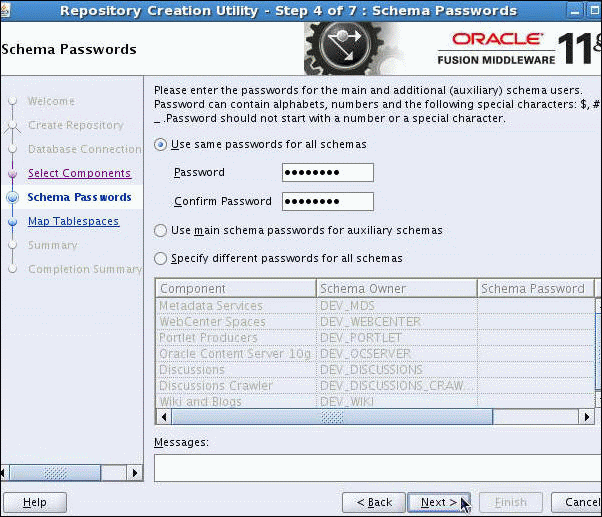 | ||||||||||||||
| 7. | In the Map Tablespaces window, click Next. A dialog box may open requesting confirmation to create the tablespaces. Click OK. Then a dialog box opens confirming the tablespaces have been created successfully. Click OK. | ||||||||||||||
| 8. | In the Summary window, click Create. A dialog box opens showing the progress of schema creation. | ||||||||||||||
| 9. | In the Completion Summary window, click Close. |
Installing WebCenter Spaces
The WebCenter installer installs the files for WebCenter Spaces, WebCenter Services, and UCM. To install WebCenter Spaces, WebCenter Services, and UCM, perform the following steps:
| 1. | Navigate to the staged location for the WebCenter installer and start the installer: $ cd /stage $ ./runInstaller -jreLoc /u01/app/oracle/product/fmwhome/jdk160_14_R27.6.5-32The installer requires the location of a JRE. When you installed Oracle WebLogic Server, a JRE was installed on your system. You can use this location to start the installer. You must supply an absolute path. The JRE location in this path is the Sun JRE. The Sun JRE is recommended when you are installing in a development environment. If you are installing in a production environment, use the JRockit JRE. | ||||||||
|---|---|---|---|---|---|---|---|---|---|
| 2. | In the Welcome window, click Next. | ||||||||
| 3. | The installer runs various tests to check system prerequisites. When it is done, click Next in the Prerequisite Checks window. | ||||||||
| 4. | In the Specify Installation Location window, enter the location of Middleware_Home, in this scenario,/u01/app/oracle/product/fmwhome/. Accept the default Oracle Home Directory and click Next.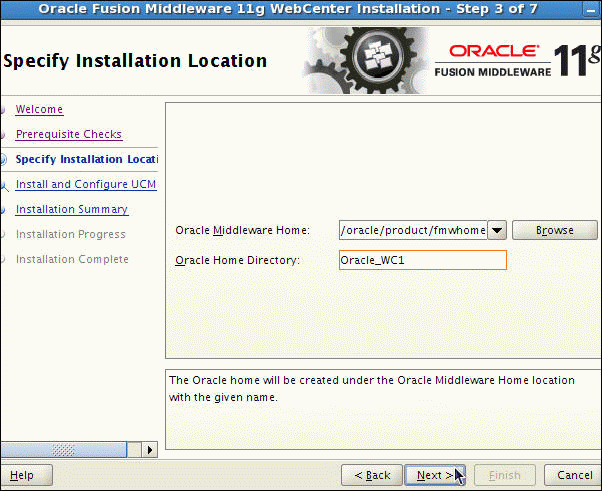 | ||||||||
| 5. | In the Specify UCM Configuration Options window, select Install and Configure Oracle Universal Content Management. Accept the defaults for Content Server Port and Content Server Admin Port and for Web Server HTTP Address the format should be http://<your_host_name>:<port_number>/<webroot>. In this scenario, it ishttp://edvmr1p0.us.oracle.com:7777/idc. Click Next. | ||||||||
| 6. | In the Specify UCM Database Details window, enter the following values and click Next. Note: These values must match the values used when you ran RCU in the previous section.
 | ||||||||
| 7. | In the Installation Summary window, click Install. Installation Progress is shown. When it is complete, click Next. | ||||||||
| 8. | In the Specify UCM Installer Directory window, enter the location of the UCM installation files,/stage/ContentServer. Click Next. UCM Installation Progress is shown . | ||||||||
| 9. | In the Installation Complete window, click Finish. |
Configuring WebCenter Spaces
The Oracle Fusion Middleware Configuration Wizard creates and configures a new WebLogic domain for Oracle WebCenter Spaces and components. To configure WebCenter Spaces and components, perform the following steps:
| 1. | Navigate to the WebCenter_Oracle_Home/common/bin directory and start the Configuration Wizard: $ cd /u01/app/oracle/product/fmwhome/Oracle_WC1/common/bin $ ./config.sh | ||||||||||||||
|---|---|---|---|---|---|---|---|---|---|---|---|---|---|---|---|
| 2. | In the Welcome window, accept the default of Create a new WebLogic domain and click Next. | ||||||||||||||
| 3. | In the Select Domain Source window, accept the default of Generate a domain configured automatically to support the following products and select the following products then click Next:
Note: You need to select Oracle WSM Policy Manager before you select Oracle WebCenter Spaces else you will receive an error. Also Oracle Enterprise Manager and Oracle JRF are selected automatically when you select Oracle WebCenter Spaces.  | ||||||||||||||
| 4. | In the Specify Domain Name and Location window, enter the following values and click Next.
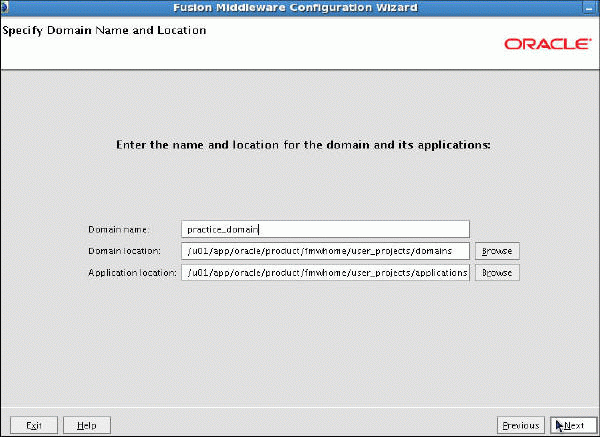 | ||||||||||||||
| 5. | In the Configure Administrator User Name and Password window, accept the default User name of weblogic and enter welcome1 twice for the password. Click Next. | ||||||||||||||
| 6. | In the Configure Server Start Mode and JDK window, accept the defaults of Development Mode and Sun SDK 1.6.0_14 and click Next. | ||||||||||||||
| 7. | In the Configure JDBC Component Schema window, select all the component schemas in the lower portion of the window. Enter the following values in the upper portion of the window and click Next.
 The Testing Connections dialog opens. | ||||||||||||||
| 8. | In the Test Component Schema window, click Next. | ||||||||||||||
| 9. | In the Select Optional Configuration window, select Administration Server and Managed Servers, Clusters and Machines. Click Next.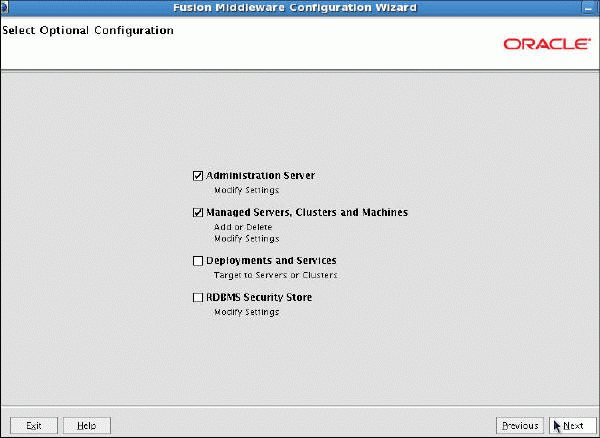 | ||||||||||||||
| 10. | In the Configure the Administration Server window, accept all the defaults and click Next. | ||||||||||||||
| 11. | In the Configure Managed Servers window, accept all the defaults and click Next. | ||||||||||||||
| 12. | In the Configure Clusters window, click Next. | ||||||||||||||
| 13. | In the Configure Machines window, click Add. Enter the following values and click Next.
 | ||||||||||||||
| 14. | In the Assign Servers to Machines window, select all the servers in the left pane and click the right arrow icon. Click Next.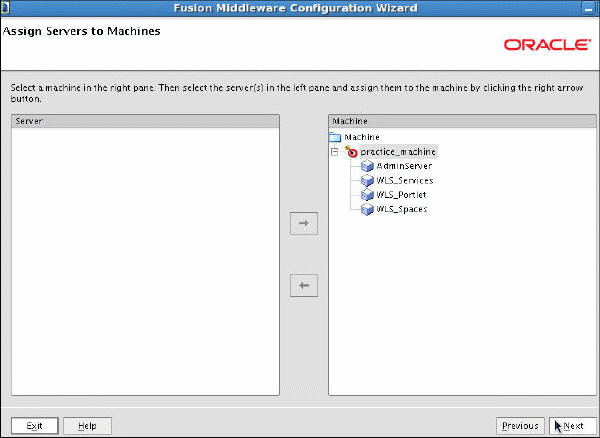 | ||||||||||||||
| 15. | In the Configuration Summary window, click Create. This may take a few minutes to complete.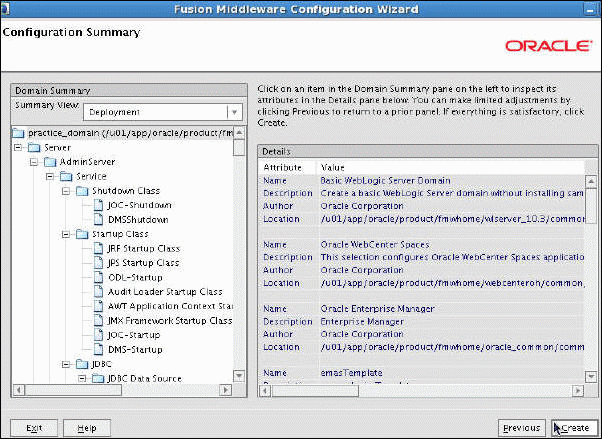 | ||||||||||||||
| 16. | In the Creating Domain window, click Done. |
Starting the WebLogic Servers
To start all the WebLogic Servers as well as the Node Manager, perform the following steps:
Starting the Administration Server
| 1. | Navigate to the domain directory and start the Administration server: $ cd /u01/app/oracle/product/fmwhome/user_projects/domains/practice_domain $ ./startWebLogic.shWait until you see the message <Server started in RUNNING mode>. Do not close this window as it will shut down the Administration server. |
|---|
Starting the Node Manager
| 1. | In a new window, navigate to the Oracle_Common_Home/common/bin directory and set the Node Manager properties: $ cd /u01/app/oracle/product/fmwhome/oracle_common/common/bin $ ./setNMProps.shYou see the message Appending required nodemanager .properties. Note: If you are installing and older 11g version of WebCenter Spaces that does not include Patch Set 1 then the Node Manager file is located in WebCenter_Oracle_Home/common/bin. |
|---|---|
| 2. | Navigate to the WebLogic_Server_Home/server/bin directory and start the Node Manager: $ cd /u01/app/oracle/product/fmwhome/wlserver_10.3/server/bin $ ./startNodeManager.shWait until y ou see the message INFO: Secure socket listener started on port 5,556. Do not close this window as it will shut down the Node Manager. |
Starting the Managed Servers
| 1. | Start the WebLogic Server Administration Console by opening a web browser and enteringhttp://<your_host_name>:7001/console. For Username enter weblogic, for Password enter welcome1then click Log In. Note: You can also start the managed servers from the commandline usingDOMAIN_DIR/bin/startManagedWebLogic.sh. 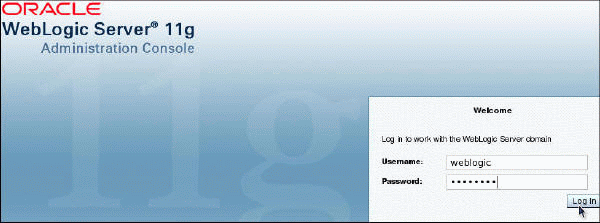 Before you see the login window a message briefly appears indicating the application is being deployed for the console. |
|---|---|
| 2. | In the left Domain Structure pane, expand Environment and click Servers.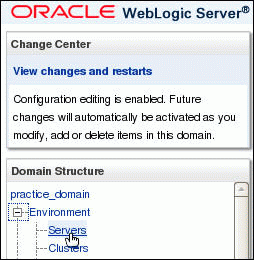 |
| 3. | In the Summary of Servers window, click the Control tab and select the three managed servers. Then click theStart button. |
| 4. | Refresh the window by clicking the Refresh icon in the browser or pressing F5 until the State for all servers isRUNNING. |
Verifying the Installation
To verify that WebCenter Spaces has been installed correctly, perform the following steps:
| 1. | Start WebCenter Spaces by opening a web browser and entering http://<your_hostname>:8888/webcenter. For User Name enter weblogic, for Password enter welcome1 then click Login. |
|---|---|
| 2. | You are now logged into WebCenter Spaces. This confirms that it has been installed correctly.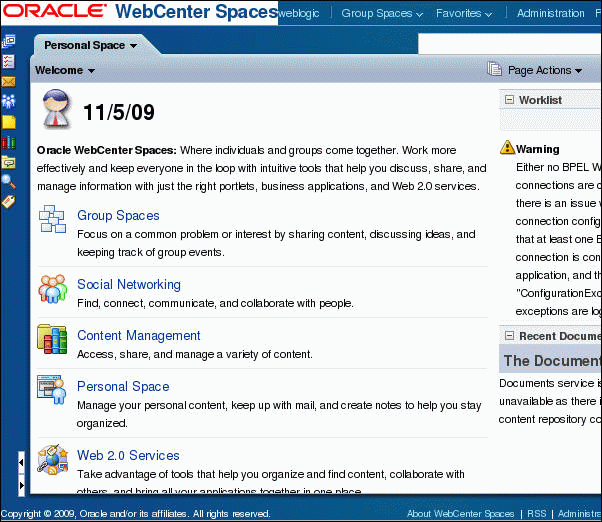 Note: The messages on the right of the window regarding the Worklist and Documents services being unavailable are because they are not configured yet. At this point WebCenter Spaces is installed and up and running but your work is not complete. You still need to configure the services you wish to use in WebCenter Spaces, for example, the Documents service (including UCM), the Worklist service, and the Discussions service. You may also wish to register portlet producers. See the Oracle Fusion Middleware Installation Guide for Oracle WebCenter 11g and theOracle Fusion Middleware Administrator's Guide for Oracle WebCenter for more information. |